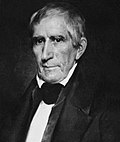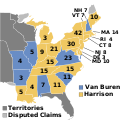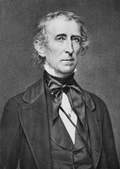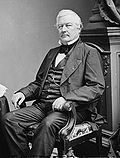Whig Party (United States)
The Whig Party was a conservative political party of the United States. Generally considered to be the de facto successor to the Federalist Party, it was famous during the years of Jacksonian democracy. It is thought to be important to the Second Party System. Operating from 1833 to 1856,[1] party was formed by Henry Clay, opposing the policies of President Andrew Jackson and the Democratic Party. The Whigs supported the importance of Congress over the importance of the executive branch. They favored a program of modernization. Their name was chosen to tell people about the American Whigs of 1776, who fought for independence. "Whig" was then a widely recognized label of choice for people who saw themselves as opposing autocratic rule.[2] The Whig Party had national leaders as Daniel Webster, William Henry Harrison, Henry Clay of Kentucky. The Whig Party also had four war heroes among them, such as Generals Zachary Taylor and Winfield Scott. Abraham Lincoln was a Whig leader in frontier Illinois.
In its over two decades of existence, the Whig Party saw two of its candidates, Harrison and Taylor, elected president. Both died in office. John Tyler became president after Harrison's death, but was thrown out from the party. Millard Fillmore, who became president after Taylor's death, was the last Whig to hold the nation's highest office.
The party was ultimately destroyed by the question of whether to allow the expansion of slavery to the territories. The anti-slavery faction successfully prevented the nomination of its own incumbent President Fillmore in the 1852 presidential election. Instead, the party nominated General Winfield Scott, who was defeated. Its leaders quit politics (as Lincoln did temporarily) or changed parties. The voter base defected to the Republican Party, various coalition parties in some states, and to the Democratic Party. By the 1856 presidential election, the party had lost its ability to maintain a national coalition of effective state parties and endorsed Millard Fillmore, now of the American Party, at its last national convention.[3]
Whig Party (United States) Media
John Quincy Adams, the 6th president, became a Whig congressman later in his career.
Henry Clay, a founder of the Whig Party in the 1830s and its 1844 presidential nominee
Daniel Webster, a leading Whig from New England
William Henry Harrison, a two-time presidential candidate who became the first Whig president in 1841 but died just one month into office
William Henry Harrison defeated Martin Van Buren in the 1840 presidential election, thereby becoming the first Whig president
President John Tyler clashed with congressional Whigs and was expelled from the party.
Zachary Taylor served in the Mexican–American War and later won the 1848 presidential election as the Whig nominee.
The United States settled the Texas-Mexico border and acquired portions of seven current states in the Treaty of Guadalupe Hidalgo. Portions of present-day Arizona and New Mexico were later acquired in the 1853 Gadsden Purchase.
A political cartoon satirizing the candidacy of either Zachary Taylor or Winfield Scott in the 1848 presidential election
Millard Fillmore, the last Whig president
References
- ↑ Holt (1999), p. 231.
- ↑ Holt (1999), pp. 27–30.
- ↑ "Our Campaigns - US President - W Convention Race - Sep 17, 1856". www.ourcampaigns.com.









